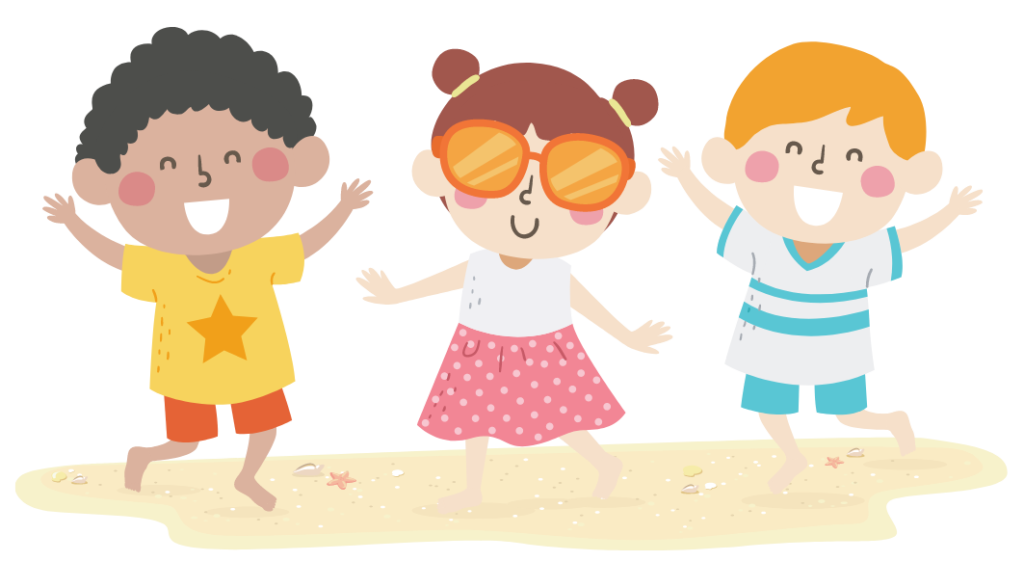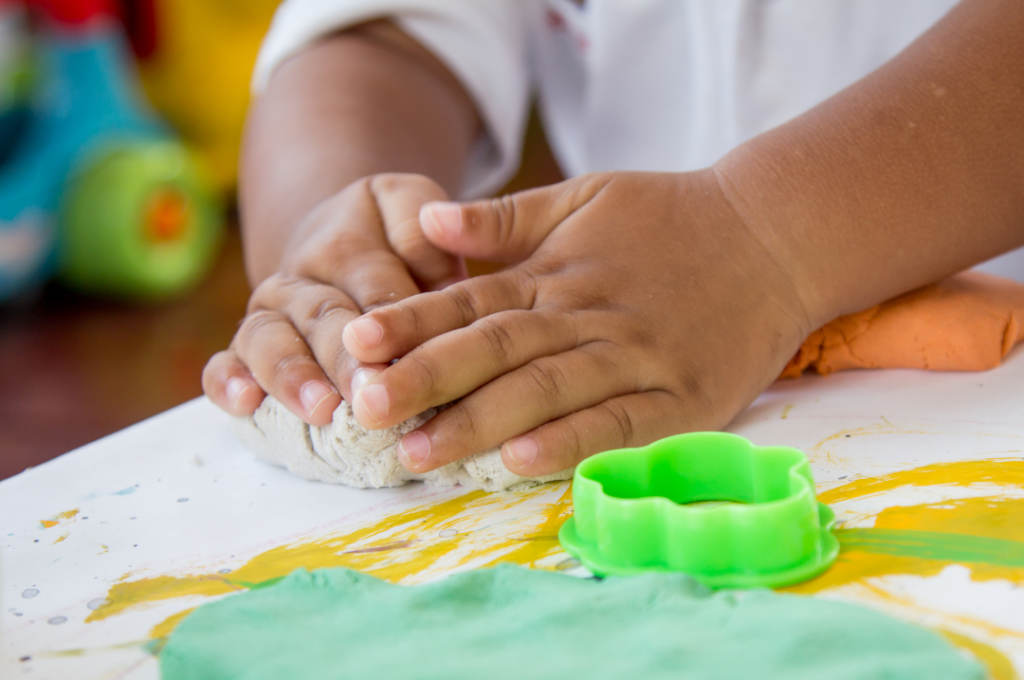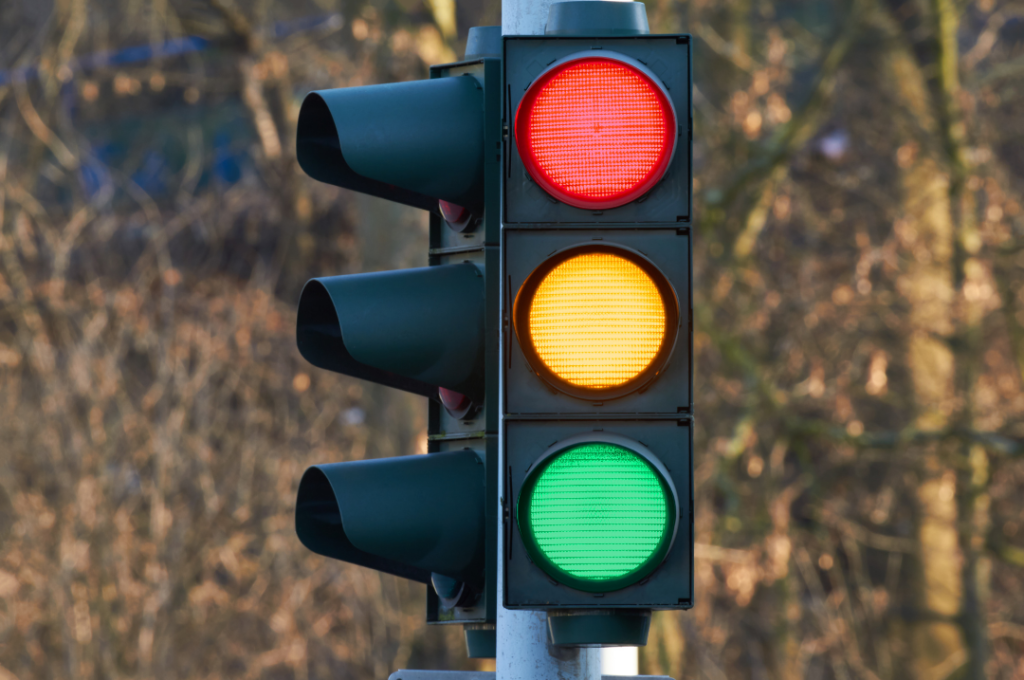Written by Grandview Kids Recreation Therapist, Maddy
Many social skills are developed through play in early childhood. Teaching your child to play and engage with their peers will help them develop friendships and build skills to develop meaningful leisure interests. Grandview Recreation Therapist, Maddy, has created some activity and game suggestions that you can do with your children to encourage social skills and peer-to-peer social communication.

These activities and games can be done with siblings, neighbours, and/or other peers close in age to your child. These activities will provide caregivers with an opportunity to encourage their child/children to develop appropriate social skills and peer-to-peer social communication.
Use variations and make modifications as needed.
Tips
- Provide choices as often as possible.
- Take breaks as needed.
- Focus on the child’s strengths. Please encourage them to use their talents. At the same time, identify their challenges and find ways to work on them together.
- Model how to play the game and use your own play and enthusiasm to promote engagement. You can use hand-over-hand support to help them understand what they need to do in the game.
- Make sure to clarify when it is my turn vs. your turn. Can use pointing, words, or other visuals if helpful. Learning to take turns in play will support learning how to take turns in social conversations.
Activity List
- I-Spy/Spot It
- Play-Doh Guessing Game
- Simon Says
- Red Light Green Light
- Fort Building
I-Spy/Spot It
This activity fosters turn-taking and is a game that requires no toys or equipment. This activity is commonly played in unstructured time with school-aged children.
- Use a picture, spot it books, or simply lookout around the room or out a window.
- You start by saying: “I spy with my little eye something that is *choose a colour*.”
- Wait for your child to guess and keep going until they guess the correct object. Your child can guess using words, pointing, leading, etc.
- Take turns going back and forth for as long as your child will tolerate. It may start at 2 minutes, and eventually, you may be able to play for 10-15.

Play-Dough Guessing Game
This activity allows your child to practice theory of mind (the idea that not everyone knows what you know), turn-taking, and creativity.
- You will need play-dough or modelling clay. You can also use tools, shapes, cookie cutters, etc.
- At a table or flat surface, set out your play-dough. Give lots of choices (colours, tools, etc.).
- Set a time limit and tell your child you will make something specific (a food, an animal, a shape, a number, etc.); you can use a visual timer if needed.
- Emphasize that what they are making is a secret and that you are playing a guessing game (this can be a challenging concept for many children – practice as much as possible).
- When the objects are ready, take turns guessing what you each made.
- Can repeat with different categories, shapes, trade materials etc. While building, you can talk about the categories, shapes you’re making, taking turns with materials (“can I use the knife” or “what foods do we like to eat?”).

Simon Says
This activity teaches skills commonly seen in group activities in school and recreation programs. Practicing at home might help develop their confidence in group settings.
- Explain to your child that you will take turns being “Simon” (it can be any character – Peppa Says, Skye Says, Ryder Says, etc., remember to follow their interests).
- Take turns just giving instructions and following the leader “touch your head, jump up and down, etc..”
- Once your child is comfortable, you can try adding the official rule; if you don’t start your sentence with “Simon Says,” you do not follow the action (this may be tricky for some children, be patient and practice).
- Then allow your child long turns being Simon!

Red Light, Green Light
Red Light, Green Light is a great activity to play with a group. This activity helps teach self-regulation and body control in a fun and exciting way.
- Start by naming each light and the meaning of each light using modelling (red light = stop, green light = go, yellow light = slow).
- To start, you can find an open space and take turns yelling out each light colour.
- Once they understand this, you can choose one person to be ‘It.’ The person moves farther away and stands with their back towards the other players. The other players will stand on a line facing the person who is its back.
- The person who is it will start calling out “Green Light/Yellow Light” and will turn around and call “Red Light,” trying to catch other players moving.
- Take turns being the leader.
- If you don’t have a big space to participate in this activity – play on the spot (run on the spot, dance, slow motion on the spot, etc.)
- Once they understand the rules, you can add different coloured lights to the activity (purple light = dance, blue light = sit, etc.).

Fort Building
This activity will support pretend/imaginative play while using problem-solving to work cooperatively with you.
- This activity involves cooperative play skills, working together as parent and child or child and peer towards a common goal.
- Ask your child if the fort should have a theme (Lion’s Den, Mermaid cave, Zoo, house, doctor’s office, castle, etc.)
- Discuss what supplies should be used and what aspects of the structure you will need (walls, door, roof, etc.)
- Gather supplies together, use blankets, pillows, chairs, and other household items to build your fort
- Build a fort together, allow for trial and error, and encourage discussion throughout
- Foster continuation of ideas by repeating their statements back to them as questions
- Your child says, “we need a door that can move,” you reply saying, “oh, we need one that moves?”. This will encourage them to continue their thought process out loud.
- If they are replying with one-word answers (“yeah” or head nodding), try to elaborate by saying, “We need a door that moves? What could we use that moves?”
- Once your fort is built, engage in pretend play – either “house” or follow your child’s theme. Assign roles and play out various scenarios (going to bed, dinner time, getting ready for school, fighting a “bad guy,” etc.).

Check out more Grandview Kids articles
- Team Grandview achieves Accreditation with Exemplary Standing, receiving a perfect score
- “Grandview Kids became my life raft” – International Day for People with Disabilities
- December: Dates of Significance
- From the search for support to finding a village: Celebrating Giving Tuesday
- Scarlett sparkles with hope in every step: Grandview Kids 2025 Holiday Campaign
